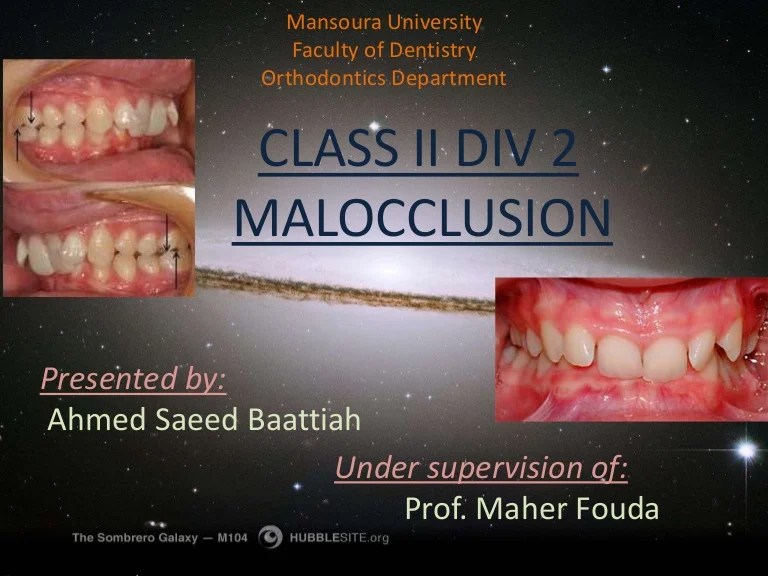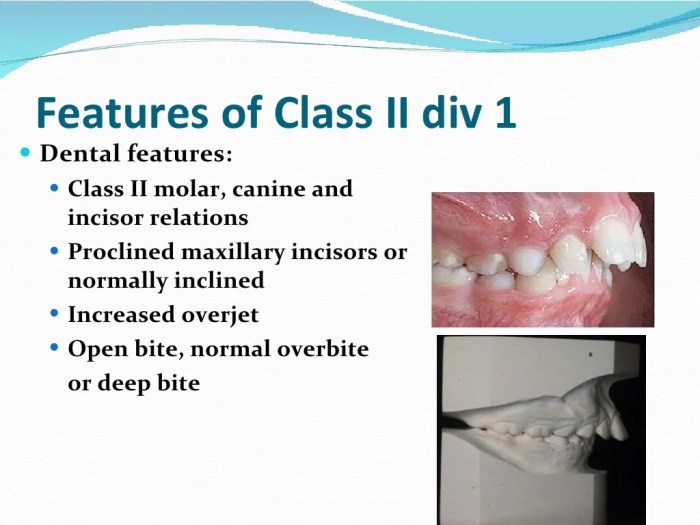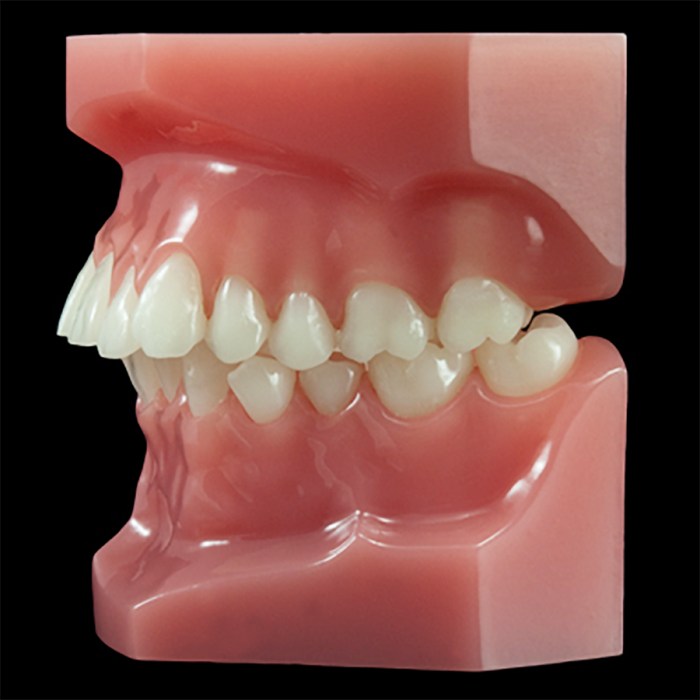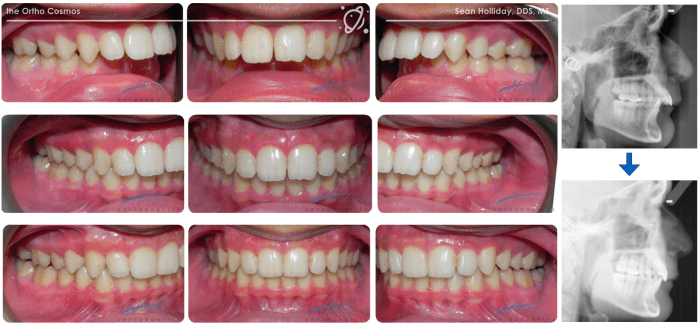Class II Malocclusion Division 1, a prevalent orthodontic condition, presents a distinctive set of dental and skeletal characteristics. This article provides a comprehensive overview of the etiology, dental and skeletal features, treatment modalities, and preventive measures associated with Class II Malocclusion Division 1, offering valuable insights for healthcare professionals and individuals seeking to understand and address this condition.
The subsequent paragraphs delve into the intricacies of Class II Malocclusion Division 1, exploring its causes, dental manifestations, skeletal features, treatment options, and preventive strategies. This information empowers readers with a thorough understanding of this condition and its management.
Etiology of Class II Malocclusion Division 1

Class II malocclusion division 1 is a dental condition characterized by an anterior displacement of the mandible relative to the maxilla. The etiology of this condition is multifactorial, involving a complex interplay of genetic, environmental, and developmental factors.
Genetic Factors
Genetic predisposition plays a significant role in the development of Class II malocclusion division 1. Studies have identified specific genes associated with an increased risk of developing this condition, including genes involved in craniofacial growth and development.
Environmental Factors
Environmental factors, such as early childhood habits and nutritional deficiencies, can also contribute to the development of Class II malocclusion division 1. Prolonged use of pacifiers or thumb sucking can lead to an anterior displacement of the mandible, while nutritional deficiencies, particularly vitamin D and calcium, can impair jaw development.
Developmental Factors
Abnormal growth patterns and muscle imbalances can also play a role in the development of Class II malocclusion division 1. Excessive growth of the mandible relative to the maxilla, or conversely, insufficient growth of the maxilla, can lead to an anterior displacement of the mandible.
Muscle imbalances, such as weak or overactive masticatory muscles, can also contribute to the development of this condition.
Dental Characteristics of Class II Malocclusion Division 1

Class II malocclusion division 1 is characterized by a distinctive set of dental features that differentiate it from other malocclusion types. These characteristics include:
Maxillary and Mandibular Arch Relationship
In Class II malocclusion division 1, the maxillary arch is positioned anteriorly to the mandibular arch. This results in an overjet, where the maxillary incisors extend horizontally beyond the mandibular incisors.
Overjet and Overbite
Overjet refers to the horizontal overlap of the maxillary incisors over the mandibular incisors. In Class II division 1, the overjet is typically increased, often exceeding 4 mm.
Overbite refers to the vertical overlap of the maxillary incisors over the mandibular incisors. In Class II division 1, the overbite may be normal, increased, or decreased.
Other Dental Anomalies
In addition to overjet and overbite, Class II malocclusion division 1 may exhibit other dental anomalies, such as:
- Crowding of the maxillary anterior teeth
- Spacing of the mandibular anterior teeth
- Proclination of the maxillary incisors
- Retroclination of the mandibular incisors
- Steep mandibular plane angle
- Increased lower facial height
These dental characteristics contribute to the overall appearance of Class II malocclusion division 1 and can have a significant impact on oral function and aesthetics.
Skeletal Characteristics of Class II Malocclusion Division 1

Class II malocclusion division 1 is characterized by specific skeletal features that differentiate it from other malocclusion types. These features involve the position of the maxilla and mandible in relation to the cranial base.
Position of the Maxilla and Mandible
In Class II malocclusion division 1, the maxilla is typically positioned forward (prognathic) relative to the cranial base, while the mandible is positioned backward (retrognathic). This results in an anteroposterior discrepancy between the maxilla and mandible, with the mandible being retruded in relation to the maxilla.
Mandibular Retrognathism, Class ii malocclusion division 1
Mandibular retrognathism is a condition where the mandible is underdeveloped or positioned too far back in relation to the maxilla. This can be caused by various factors, including genetic inheritance, environmental influences, or a combination of both. Mandibular retrognathism contributes to the anteroposterior discrepancy characteristic of Class II malocclusion division 1.
Maxillary Prognathism
Maxillary prognathism, on the other hand, refers to a condition where the maxilla is positioned too far forward in relation to the cranial base. This can also be caused by genetic or environmental factors, and it can contribute to the anteroposterior discrepancy seen in Class II malocclusion division 1.The
combination of mandibular retrognathism and maxillary prognathism leads to an imbalance in the skeletal relationship between the maxilla and mandible, resulting in the characteristic skeletal features of Class II malocclusion division 1.
Treatment Options for Class II Malocclusion Division 1

The treatment of Class II malocclusion division 1 aims to correct the malocclusion and establish a stable, functional, and esthetic occlusion. Treatment options vary depending on the severity of the malocclusion and the patient’s age and individual needs.
Orthodontic Treatment
Orthodontic treatment is the primary treatment modality for Class II malocclusion division 1. It involves the use of braces or aligners to gradually move the teeth into their correct positions.
- Braces:Traditional metal braces are the most common type of orthodontic treatment. They consist of metal brackets that are bonded to the teeth and connected by wires. The wires apply pressure to the teeth, causing them to move over time.
- Aligners:Aligners are clear, removable trays that are custom-made to fit the patient’s teeth. They are worn for 20-22 hours per day and gradually move the teeth into their correct positions.
Orthognathic Surgery
In severe cases of Class II malocclusion division 1, orthognathic surgery may be necessary to correct the underlying skeletal discrepancy. Orthognathic surgery involves surgically repositioning the jaws to create a more balanced and harmonious facial profile.
The decision to undergo orthognathic surgery is made on a case-by-case basis. Factors that are considered include the severity of the malocclusion, the patient’s age, and their overall health.
Prevention and Early Intervention for Class II Malocclusion Division 1

Early detection and intervention are crucial for Class II malocclusion division 1 to prevent the progression of the condition and improve the chances of successful treatment. Preventive measures and early non-invasive interventions can significantly reduce the risk of developing this malocclusion or mitigate its severity.
Preventive Measures
- Encourage breastfeeding:Breastfeeding promotes proper jaw development and reduces the risk of malocclusions.
- Avoid prolonged pacifier or bottle use:Prolonged use can lead to anterior open bite and affect jaw growth.
- Promote healthy oral habits:Encourage regular brushing, flossing, and dental check-ups to maintain oral health and prevent dental problems that may contribute to malocclusion.
- Monitor jaw growth:Parents and caregivers should observe their child’s jaw development and seek professional advice if any concerns arise.
Early Non-Invasive Interventions
Myofunctional therapy and other non-invasive treatments can be effective in early intervention for Class II malocclusion division 1. These treatments focus on correcting abnormal muscle function and improving jaw alignment.
- Myofunctional therapy:This therapy addresses tongue thrusting, mouth breathing, and other muscle imbalances that contribute to malocclusion.
- Habit appliances:Removable appliances, such as the Twin Block, can be used to correct anterior open bite and promote mandibular advancement.
- Functional appliances:These appliances, such as the Herbst appliance, can be used to improve jaw alignment and stimulate mandibular growth.
Expert Answers
What are the primary causes of Class II Malocclusion Division 1?
Genetic factors, environmental influences, abnormal growth patterns, and muscle imbalances contribute to the development of Class II Malocclusion Division 1.
How is Class II Malocclusion Division 1 typically diagnosed?
Diagnosis involves a thorough clinical examination, including assessment of dental relationships, skeletal features, and muscle function.
What are the treatment options for Class II Malocclusion Division 1?
Treatment options include orthodontic treatment with braces or aligners, and in severe cases, orthognathic surgery to correct skeletal discrepancies.
Can Class II Malocclusion Division 1 be prevented?
Early detection and intervention, including myofunctional therapy and habit correction, can help reduce the risk of developing Class II Malocclusion Division 1.